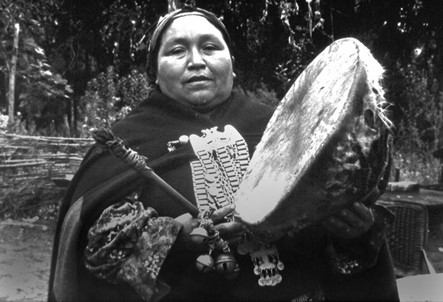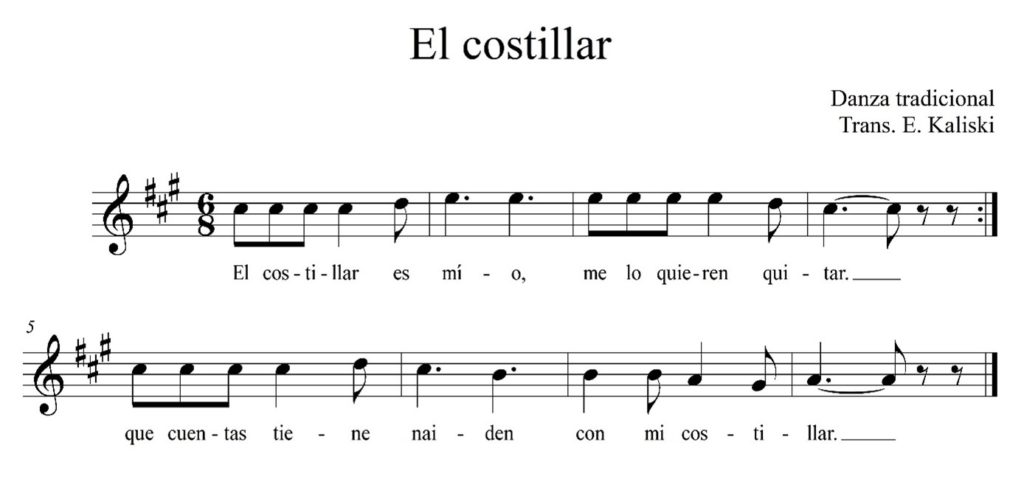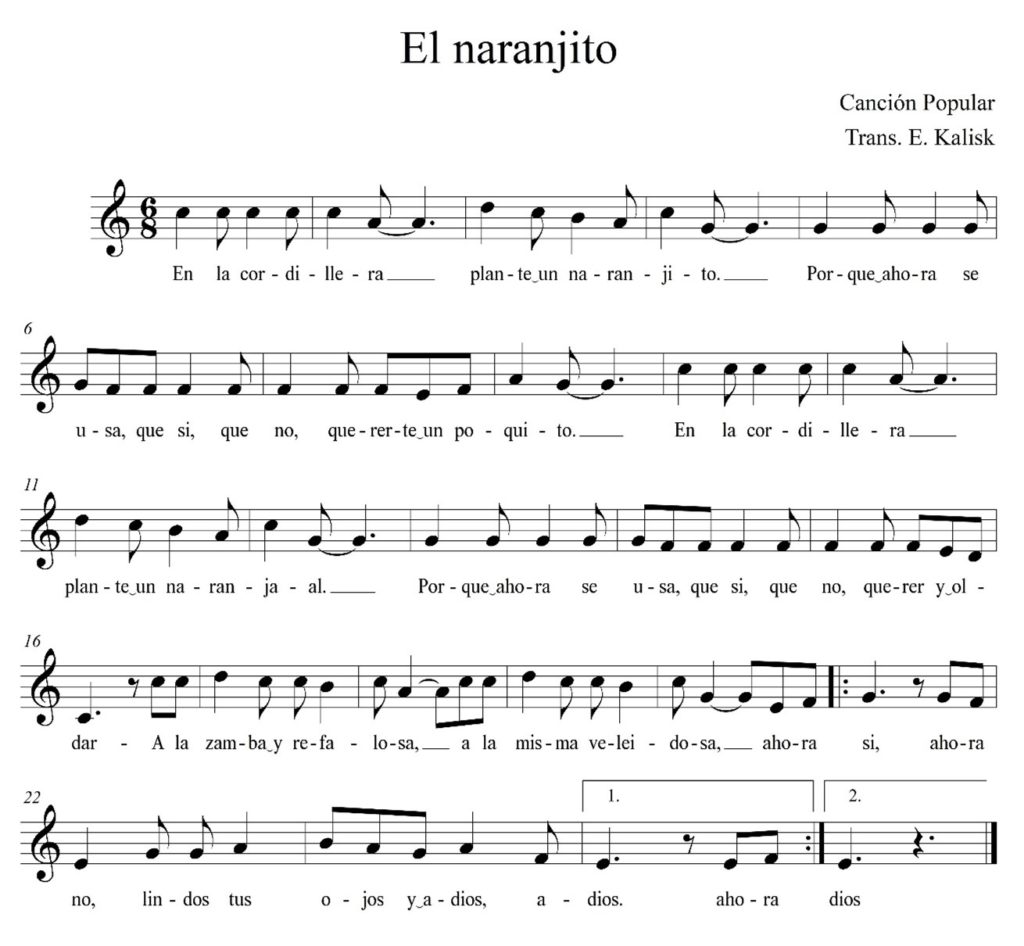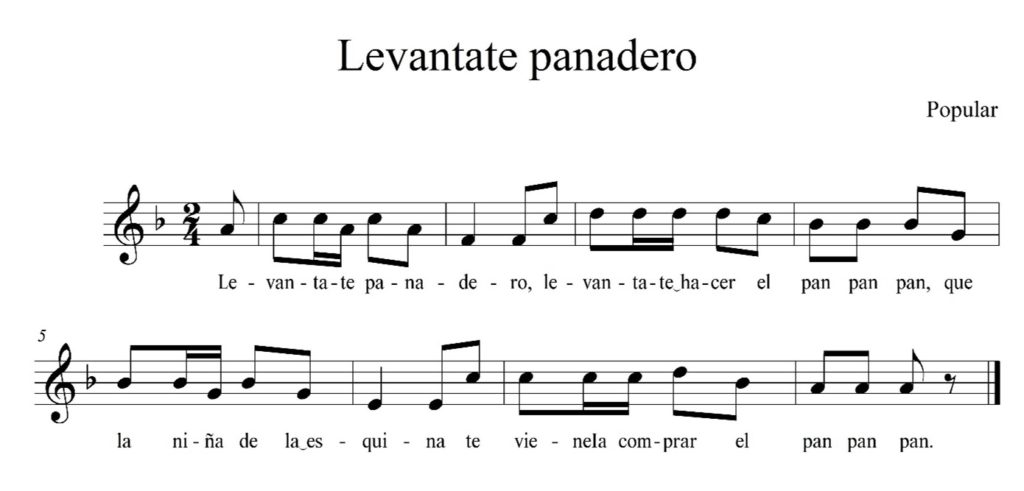
From Charango to Kultrún: The Richness of Chilean Music
Mexico, my native country, is in the northern hemisphere, yet shares the same language with Chile, far away in the southern hemisphere. Although both countries are part of Latin America, they are so far apart that when one is in the middle of winter, the other enjoys a hot summer.

A focus on traditional Chilean music is currently reflected in the plans and programs developed by the Chilean Ministry of Education for all levels of music education, where a large amount of Chilean repertoire is proposed for study. Chileans place high educational value on their own music, including those created by native cultures and those resulting from cultural mixture due to emigration. For example, in Chile there exist both traditional Andean orchestras, as well as “comparsas”: groups of musicians playing regional music with dancers performing specific choreography. Comparsas are especially active in carnivals, and usually each group wears a particular costume in order to be identified by spectators.
As a Mexican, it has been a huge challenge to teach music in Chilean schools, but at the same time it has been enriching, as I have approached new-to-me repertoire in a completely new (Dalcrozian) way for the students.
An example of this teaching uses various works based on the music of the Mapuches, a native people of Chile located in the Araucanía region. This music totally escapes the parameters of Western music. There is no clear form; the wind instruments have an imprecise tuning; and the singing, which is performed in their native language by the spiritual guide, the “machi,” is powerful and energetic. The machi improvises songs, playing with low and high sounds and with the tempo, speaking or shouting, and sometimes inviting the group to sing in a call-and-response. For this culture, music is a form of communication with the spirits. The instruments have the power of expressing emotions that words alone cannot (Chilean Museum of Pre-Columbian Art, n.d.).
The music of the Mapuches has a hypnotizing, rhythmic character, with elements that can be broken down for study using Dalcroze eurhythmics activities. The first of these is a steady beat accompanied by various ostinati, some of which are heard in percussion and others in wind instruments, both high and low. The steady beat and ostinatos can be embodied in different ways: for example, locomoting to the beat while hand drums are played in association with the kultrún (traditional Mapuches drum) (see figure 1). Also, handkerchiefs could be moved in association with the melodies of the wind instruments.

Source: Chilean Museum of Pre-Columbian Art
On one occasion, I worked on a Mapuche song with five- and six-year-olds. As they were very young and we were just starting our music classes together, I was not sure how to approach the song. I gave them handkerchiefs and asked them to listen to the music, moving their handkerchief to a sound that caught their attention. I then asked the students to copy the movement of another student of their choice. In this way, we created a plastique animée where the beat, the ostinato of the kultrún, the melodies of the flutes, and the singing were represented.
Northern Chile is rich in music. Among the musical genres that coexist is the huayno, a pre-Columbian dance from the high plateau. The huayno is a very meaningful dance which represents the commingling of the Quechua, Aymara, and Spanish cultures (Memoria chilena, n.d.). The accompaniment uses instruments typical of the region, such as charangos, pan flutes, tarkas, lichi guayos, quenas, bass drums, drums, and brass.
The huayno accompaniments are excellent examples of topics to explore in eurhythmics activities such as simple duple meter, rhythm patterns, and anacrusic phrases. In addition, there are many opportunities for vocal improvisation games because the vast majority of existing songs use a pentatonic scale.
In figure 2 we have an excerpt from “La Vicuñita,” a piece suggested by MINEDUC for the Study Program for the Third Basic Year (MINEDUC, 2013). This song gives us the opportunity to work on 2-time, syncopation, and question-answer phrasing. In addition, when listening to recordings of this music, we can find interesting elements to incorporate into a eurhythmics activity, such as the drum roll that constantly appears on the bass drums.

Taken from Programa de Música para la Educación Básica, Tercer año (p. 63) MINEDUC (2012). Chilean traditional song.
Traveling from the center to the south of Chile, we find musical genres that arrived at the end of the nineteenth century and, with time, have managed to acquire their own characteristics. The Chiloé waltz, the chacarera, the chamamé, and the costillar are examples, all of them in 6/8.
The costillar is a male dance of challenge where the opponents dance around a bottle that is placed on the floor. This dance is very popular in the region of Chiloé, although it can also be found in and around Chillán, in the center-south of the country.
The movement used by the dancers corresponds to what in Dalcroze eurhythmics is known as the skip (salticar in Spanish), which allows the movers to clearly feel the two pulses of this compound meter. In the dance, each dancer must be clear about the amount of time he needs to take for the amount of space he must traverse and the energy he needs to make it, encapsulating three fundamental aspects within Dalcroze eurhythmics: time, space, and energy.

Taken from Método de Guitarra Chilena (1987) Rodriguez Moretti, E. and Kaliski Kriguer, E. Editorial Universitaria.
This melody, always grouped in four-bar phrases, allows us to experiment with phrasing. One such idea involves using a bottle which one dances around in the traditional folk dance. In a eurhythmics adaptation, one person holds the bottle in their hand and steps the melodic rhythm until they reach another partner to whom they give the bottle at the end of the phrase. Another idea could be to organize the group in pairs: one partner goes out, moving the melodic rhythm and carrying the bottle in their hand, and the other follows the same route four bars later until they catch up in a sort of chase. Both games would also work by moving instead to the rhythm of the guitar, which is the skip or salticado (quarter note-eighth note).
Also in the south of Chile is the rin, a popular dance from the island of Chiloé. It consists of a group of participants, usually two men and two women, who execute different turns and figures as ordered by the voice of a caller. It is impossible not to think of Dalcrozian verbal commands such as hip and hop that indicate us to change action in a eurhythmics class. I find it wonderful that the rin is a dance involving moving through space with a clear direction, as you can take this to think about different ways of stepping all the different rhythm patterns. In the classic rin, the movements involve stepping divisions while clapping beats. In a Dalcroze activity, we could change the roles of hands and feet with a verbal command. Another idea is to bounce balls on the downbeats. This could be done individually, where each person steps the beats while the bouncing ball shows the downbeats. This could also be done in pairs where the ball is bounced from one to the another on the downbeats.
Figure 4 shows us a rin called “El rabel,” where the melodic rhythm is composed of several sixteenth-note permutations. This is an excellent Chilean repertoire piece to practice these rhythmic figures. Students could change from walking quarter notes to eighth notes, later including sixteenth notes, with quick reaction commands increasing or decreasing the number of divisions per beat.
We can also use the rin with inhibition and excitation exercises: for example, the students locomote the sixteenth notes. At hop, they stop their feet and gently tap the sixteenth notes with their hands at the sides. However, at hop, the music changes to the beat so that students must internally subdivide the beat. Another example would be to clap the four sixteenth notes and remove an indicated pulse (one, two, three, or four), resulting in rhythm patterns. The teacher could even call for two and four to be removed, resulting in two eighth notes; or two and three, to hear the dotted eighth note and a sixteenth note, a figure that appears a couple of times during the piece.

Taken from Método de Guitarra Chilena (1987) Rodriguez Moretti, E. and Kaliski Kriguer, E. Editorial Universitaria.
Violeta Parra composed one of the most famous rins in Chile, the “Rin del angelito” (see figure 5). However, this rin is not meant to be danced. It was written to commemorate the death of her daughter. In the Chilean countryside, a child who died before their third birthday is called an “angelito” (little angel). It is customary to dress the corpse of the dead child in white, simulating an angel. One should not cry, because it was believed when a small child dies, they go directly to heaven, and crying could damage their soul. Thus, this is a sad but very beautiful song. If the text causes us distress, we can always drop the lyrics and study the melody alone.

Taken from Método de Guitarra Chilena (1987) Rodriguez Moretti, E. and Kaliski Kriguer, E. Editorial Universitaria.
Many traditional Chilean dances are accompanied by a handkerchief. Similar to the use of scarves in a eurhythmics class, Chileans use handkerchiefs enthusiastically, waving them to the beat. The cueca and the resfalosa are examples of these dances accompanied by a handkerchief.
The resfalosa has a roguish and gallant air. It owes its name to a dance step that resembles the slipping or shuffling of the feet, as if one were wiping the floor. The dance takes place within an imaginary circle divided in two, where two people occupy their own space without invading each other’s space. The handkerchief has no particular way of moving, but is usually waved above the head. The dance includes sliding steps, low jumps, and the occasional bouncing or stomping step, different options that can be suggested in the improvisation at the piano.
“El naranjito” (see figure 6) refers to some of Chile’s natural beauties. The two first stanzas mention the Andes mountain range, which serves as a natural border throughout the country, a mountain range whose view is imposing because of its immensity. The last stanza mentions a mighty river, which is surely fed with water from the melting snow that year after year covers the beautiful mountain range. The narrator is a fugitive who found asylum in the mountains on the other side of the river. Due to the fugitive’s clandestine situation, he cannot find a permanent love; he sings “now yes, now no” (ahora si, ahora no), a recurrent phrase in Chilean music.
The A section has a crusic melody and regular phrasing, but the B section is anacrusic and uses phrases of different lengths. In a eurhythmics lesson, students could embody this song/dance with a scarf, like the traditional dance itself. But we could also try something different, like standing in a circle, palm to palm. The class sings the song, swaying from one side to the other with the beat, and at hip, performs the chassé rhythm with the feet.

Taken from Método de Guitarra Chilena (1987) Rodriguez Moretti, E. and Kaliski Kriguer, E. Editorial Universitaria.
More than three thousand kilometers offshore Chile is Rapa Nui, also known as Easter Island. This island is home to Polynesian music, resulting in danceable, joyful, and cadenced melodies. The music of this region is completely different from that of the continent. One example is “Ka tere te vaka,” a melody that narrates the arrival of Hotu Matua and Avareipúa to the island. This song is actually a spell that Hotu Matua casts on his sister with the intention of crashing her canoe so that he would be the first to reach the island and therefore become ruler. The song is performed by a person who at the same time is making a kai-kai: interweaving threads to create different figures to visually represent the narrative. The image that results at the end of the weaving (see figure 7) symbolizes Avareipúa’s canoe (PUCV, 2018).


As can be seen in figure 8, the melody implies both the tonic and dominant harmonies, making it a great piece to practice this concept. The phrases are grouped in regular sets of two bars, and this symmetry facilitates playing around with the rhythms. Students could sit in circles and show the beat with drums, sticks, or simply the palms. The students could pass the beat, changing directions at a verbal command. To add difficulty, hop could be said to change from playing the beat to marking the measure. As the text is quite complicated to sing and learn, it is suggested to work with recorded music.

This transcription has been generously shared by the Orff Group Chile. It is a version that is part of an unpublished project.
Within Latin American children’s repertoire there are many songs that exist in different versions throughout the vast region. In Chile, I have discovered some beautiful songs that I had never heard before, like the one I present next.
“Levántate panadero” (Get Up, Baker) has a catchy melody that is easy to learn with simple, repetitive lyrics (see figure 9). This song works well with young and not-so-young children. It can be sung and accompanied with different hand games: for example, in pairs, students face each other and clap their hands to the beat. At “pan, pan, pan,” they high-five their partner. This same idea can be done individually, tapping the beats on the legs and clapping the “pan, pan, pan.”
To incorporate gross motor movement, students could sing while standing; at the “pan, pan, pan” they step the melodic rhythm in place. Students could walk the beats while singing and simultaneously clap the “pan, pan, pan.” If this works well, the students could be in a circle: one walks the beat until they reach a partner and high-fives them with the “pan, pan, pan.” This partner then moves the next phrase.

Taken from Música folklórica infantil chilena (1980) Pérez Ortega, J. Ediciones Universitarias de Valparaíso.
These songs, dances, and activities are just some examples of traditional Chilean music that I have used in preschool, basic, and university-level music education. Thanks to the wide variety of musical genres and dances found throughout Chile, I have been successful at teaching musical concepts through Dalcroze eurhythmics games and activities. As a Mexican who has immigrated to Chile, I have always approached the culture of the country where I now live and work with respect. I thank Professor Carlos Miró for the suggestions made to this work.
References
- Memoria chilena (n.d.) Huaynos. Bailes folklóricos de Chile. Biblioteca Nacional de Chile
- Ministry of Education of Chile (2013) Música. Programa de estudio para Tercero Básico, MINEDUC.
- Ministry of Education of Chile (n.d) Curriculum nacional. MINEDUC. https://www.curriculumnacional.cl/portal/Educacion-General/Musica/
- Chilean Museum of Pre-Columbian Art (n.d.) Música y danza mapuche. http://chileprecolombino.cl/arte/musica-y-danza/mapuche/
- Pérez Ortega, J. (1980) Música folklórica infantil chilena. Ediciones universitarias de Valparaíso.
- PUCV (2018) Pontificia Universidad Católica de Valparaíso. Fondo Margot Loyola- Kai Kai. https://www.youtube.com/watch?v=7jRyWNQ_eq0 Rodriguez Moretti, E. and Kaliski Kriguer, E. (1987) Método de Guitarra Chilena. Editorial Universitaria
This article was originally published in the Spring 2022 issue of Dalcroze Connections, Vol. 6 No. 2.